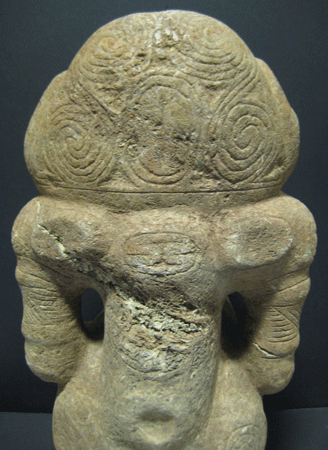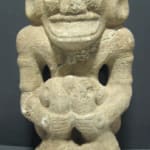Taino Stone Zemi Sculpture, 1200 CE - 1500 CE
Stone
8 x 15.5
BF.048
Further images
Carved from a pale cream stone, this sculpture represents a Taino zemi- the physical manifestation of a god, spirit or ancestor. The Taino were polytheistic and worshipped a creator deity,...
Carved from a pale cream stone, this sculpture represents a Taino zemi- the physical manifestation of a god, spirit or ancestor. The Taino were polytheistic and worshipped a creator deity, Yucahu Maorocoti, and a fertility goddess called Attabeira. Beneath these supreme deities were a host of lesser gods, including former Taino chieftains (caciques) and shamans that had been deified after their deaths. Ancestor worship was a central part of the Taino religious system and helped to bolster the political and moral authority of the chieftains. According to Spanish chroniclers, the bones of high status individuals were carefully stored in wooden urns or hung from the rafters of houses. This belief in the talismanic qualities of skeletal remains may explain the emaciated, skeletal appearance of zemi sculptures. Stone examples such as this one would have belonged to the chieftain or a high status member of his retinue. Although their precise function is unknown, the Spanish certainly believed that they were connected to fertility rites. Equally convincing is the argument that they played a role in cohoba ceremonies. These were conducted by shamans, who communicated with the souls of the deceased under the influence of the hallucinogenic cohoba. Surviving mortars, pestles and other ceremonial items all seem to be connected with this ritual. The distinctive crouching position of this figure, confirms the connection because it reflects the same position adopted by shamans during their trance.
The figure crouches on a round pedestal, with his knees raised towards the chest and his feet facing inwards. The arms are bent at the elbow, and the hands tightly grasp the lower legs. The zemi is naked except for elaborate incised adornments around the upper arms. The joints are indicated by deeply carved roundels and the back of the head is incised with complex geometric motifs. These may reflect the pattern of the textiles or tattoos worn by the Taino elite and they are also thought to hold a cosmological significance. The facial features are striking with deeply carved sunken orbits and a wide protruding jaw. There has been some damage to the stone, especially across the upper chest, but this may well reflect its usage during the Taino heyday (c.1200-1500). In addition to its historic significance, this piece strikes us with its bold carving and abstract qualities. (AM)
The figure crouches on a round pedestal, with his knees raised towards the chest and his feet facing inwards. The arms are bent at the elbow, and the hands tightly grasp the lower legs. The zemi is naked except for elaborate incised adornments around the upper arms. The joints are indicated by deeply carved roundels and the back of the head is incised with complex geometric motifs. These may reflect the pattern of the textiles or tattoos worn by the Taino elite and they are also thought to hold a cosmological significance. The facial features are striking with deeply carved sunken orbits and a wide protruding jaw. There has been some damage to the stone, especially across the upper chest, but this may well reflect its usage during the Taino heyday (c.1200-1500). In addition to its historic significance, this piece strikes us with its bold carving and abstract qualities. (AM)





